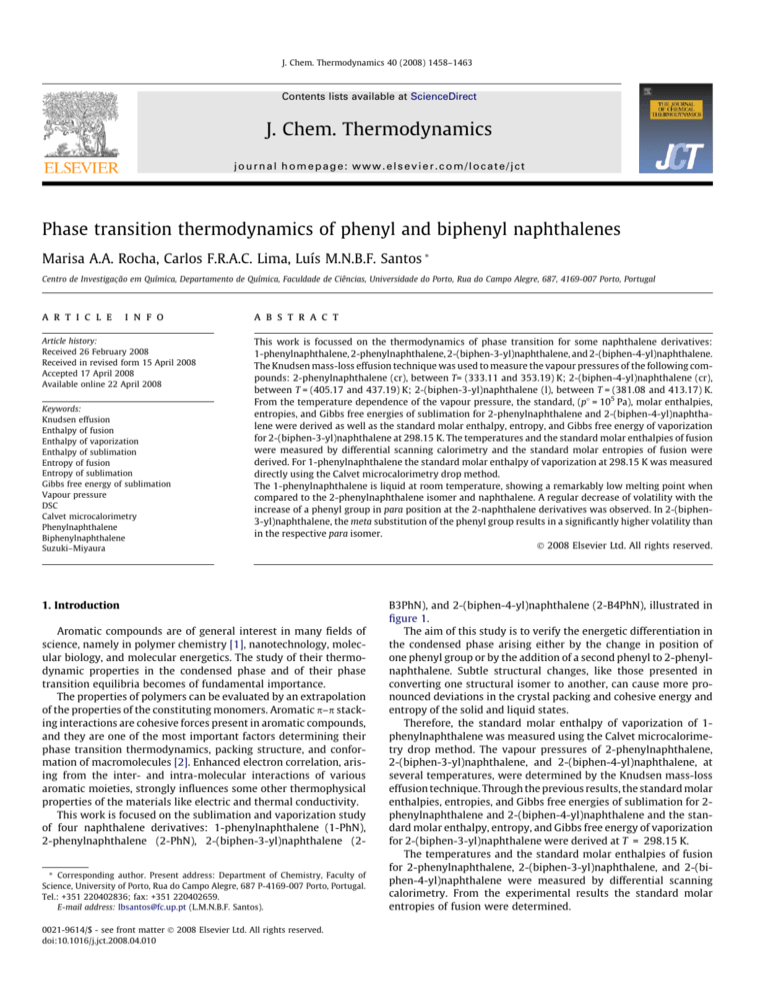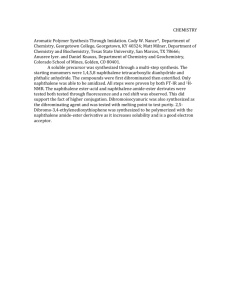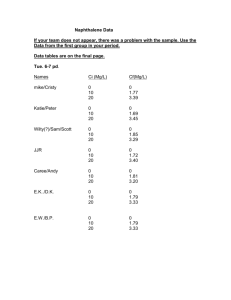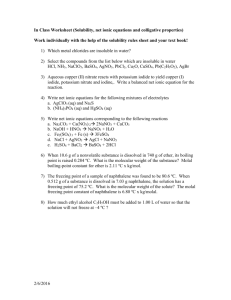
J. Chem. Thermodynamics 40 (2008) 1458–1463
Contents lists available at ScienceDirect
J. Chem. Thermodynamics
journal homepage: www.elsevier.com/locate/jct
Phase transition thermodynamics of phenyl and biphenyl naphthalenes
Marisa A.A. Rocha, Carlos F.R.A.C. Lima, Luís M.N.B.F. Santos *
Centro de Investigacßão em Química, Departamento de Química, Faculdade de Ciências, Universidade do Porto, Rua do Campo Alegre, 687, 4169-007 Porto, Portugal
a r t i c l e
i n f o
Article history:
Received 26 February 2008
Received in revised form 15 April 2008
Accepted 17 April 2008
Available online 22 April 2008
Keywords:
Knudsen effusion
Enthalpy of fusion
Enthalpy of vaporization
Enthalpy of sublimation
Entropy of fusion
Entropy of sublimation
Gibbs free energy of sublimation
Vapour pressure
DSC
Calvet microcalorimetry
Phenylnaphthalene
Biphenylnaphthalene
Suzuki–Miyaura
a b s t r a c t
This work is focussed on the thermodynamics of phase transition for some naphthalene derivatives:
1-phenylnaphthalene, 2-phenylnaphthalene, 2-(biphen-3-yl)naphthalene, and 2-(biphen-4-yl)naphthalene.
The Knudsen mass-loss effusion technique was used to measure the vapour pressures of the following compounds: 2-phenylnaphthalene (cr), between T= (333.11 and 353.19) K; 2-(biphen-4-yl)naphthalene (cr),
between T = (405.17 and 437.19) K; 2-(biphen-3-yl)naphthalene (l), between T = (381.08 and 413.17) K.
From the temperature dependence of the vapour pressure, the standard, (p = 105 Pa), molar enthalpies,
entropies, and Gibbs free energies of sublimation for 2-phenylnaphthalene and 2-(biphen-4-yl)naphthalene were derived as well as the standard molar enthalpy, entropy, and Gibbs free energy of vaporization
for 2-(biphen-3-yl)naphthalene at 298.15 K. The temperatures and the standard molar enthalpies of fusion
were measured by differential scanning calorimetry and the standard molar entropies of fusion were
derived. For 1-phenylnaphthalene the standard molar enthalpy of vaporization at 298.15 K was measured
directly using the Calvet microcalorimetry drop method.
The 1-phenylnaphthalene is liquid at room temperature, showing a remarkably low melting point when
compared to the 2-phenylnaphthalene isomer and naphthalene. A regular decrease of volatility with the
increase of a phenyl group in para position at the 2-naphthalene derivatives was observed. In 2-(biphen3-yl)naphthalene, the meta substitution of the phenyl group results in a significantly higher volatility than
in the respective para isomer.
Ó 2008 Elsevier Ltd. All rights reserved.
1. Introduction
Aromatic compounds are of general interest in many fields of
science, namely in polymer chemistry [1], nanotechnology, molecular biology, and molecular energetics. The study of their thermodynamic properties in the condensed phase and of their phase
transition equilibria becomes of fundamental importance.
The properties of polymers can be evaluated by an extrapolation
of the properties of the constituting monomers. Aromatic p–p stacking interactions are cohesive forces present in aromatic compounds,
and they are one of the most important factors determining their
phase transition thermodynamics, packing structure, and conformation of macromolecules [2]. Enhanced electron correlation, arising from the inter- and intra-molecular interactions of various
aromatic moieties, strongly influences some other thermophysical
properties of the materials like electric and thermal conductivity.
This work is focused on the sublimation and vaporization study
of four naphthalene derivatives: 1-phenylnaphthalene (1-PhN),
2-phenylnaphthalene (2-PhN), 2-(biphen-3-yl)naphthalene (2-
* Corresponding author. Present address: Department of Chemistry, Faculty of
Science, University of Porto, Rua do Campo Alegre, 687 P-4169-007 Porto, Portugal.
Tel.: +351 220402836; fax: +351 220402659.
E-mail address: lbsantos@fc.up.pt (L.M.N.B.F. Santos).
0021-9614/$ - see front matter Ó 2008 Elsevier Ltd. All rights reserved.
doi:10.1016/j.jct.2008.04.010
B3PhN), and 2-(biphen-4-yl)naphthalene (2-B4PhN), illustrated in
figure 1.
The aim of this study is to verify the energetic differentiation in
the condensed phase arising either by the change in position of
one phenyl group or by the addition of a second phenyl to 2-phenylnaphthalene. Subtle structural changes, like those presented in
converting one structural isomer to another, can cause more pronounced deviations in the crystal packing and cohesive energy and
entropy of the solid and liquid states.
Therefore, the standard molar enthalpy of vaporization of 1phenylnaphthalene was measured using the Calvet microcalorimetry drop method. The vapour pressures of 2-phenylnaphthalene,
2-(biphen-3-yl)naphthalene, and 2-(biphen-4-yl)naphthalene, at
several temperatures, were determined by the Knudsen mass-loss
effusion technique. Through the previous results, the standard molar
enthalpies, entropies, and Gibbs free energies of sublimation for 2phenylnaphthalene and 2-(biphen-4-yl)naphthalene and the standard molar enthalpy, entropy, and Gibbs free energy of vaporization
for 2-(biphen-3-yl)naphthalene were derived at T = 298.15 K.
The temperatures and the standard molar enthalpies of fusion
for 2-phenylnaphthalene, 2-(biphen-3-yl)naphthalene, and 2-(biphen-4-yl)naphthalene were measured by differential scanning
calorimetry. From the experimental results the standard molar
entropies of fusion were determined.
1459
M.A.A. Rocha et al. / J. Chem. Thermodynamics 40 (2008) 1458–1463
A
B
C
D
FIGURE 1. Structural formulas of: 1-phenylnaphthalene (A); 2-phenylnaphthalene (B); 2-(biphen-4-yl)naphthalene (C), and 2-(biphen-3-yl)naphthalene (D).
2. Experimental section
2.2. Calvet microcalorimetry
2.1. Synthesis, purification, and characterization
The standard molar enthalpy of vaporization of 1-phenylnaphthalene was measured in a high temperature Calvet microcalorimeter, model SETARAM HT 1000, using a similar technique of the
drop method described by Skinner et al. [6]. The measuring procedure and the description of the apparatus have been described recently in detail [7].
Samples of about 5–9 mg of each compound were placed into
thin capillary tubes, sealed at one end, and were dropped simultaneously with the corresponded blank tube at room temperature
into the hot reaction zone of the calorimeter. The heating of the
sample from room temperature to the calorimeter temperature is
observed by an endothermic peak. When the calorimetric cells
reach thermostability, the sample is removed from the hot-zone
by vaporization into the vacuum.
The capillary tubes were weighted on a Mettler Toledo XS-105
Dual Range analytical balance with a sensitivity of 105 g. The
blank heat capacity corrections were performed due to differences
in the mass of both capillary tubes and the different sensibilities of
the two calorimetric cells.
The standard molar enthalpy of vaporization at T = 298.15 K
g;T
was calculated from the experimental value of Dl;298:15
K Hm , at the
temperature T of the hot zone using the following equation:
The compounds 2-phenylnaphthalene [CAS Number 612-94-2],
2-(biphen-3-yl)naphthalene, and 2-(biphen-4-yl)naphthalene were
synthesized using the Suzuki–Miyaura aryl cross-coupling method
by adapting the procedure described in the literature [3,4]. As represented schematically in figure 2 a mixture of K2CO3 (15 mmol),
Pd(OAc)2 (0.1 mmol), 2-bromonaphthalene (10 mmol), boronic acid
(15 mmol), distilled water (35 cm3), and DMF (30 cm3) was stirred
for approximately 8 h at 360 K. Afterwards the reaction mixture
was extracted four times with ethyl acetate. The product was purified by recrystallization from ethanol. The three compounds were
synthesized by this same procedure.
The compound 1-phenylnaphthalene [CAS Number 605-02-7]
was obtained commercially from Sigma–Aldrich Chemical Co. with
the assessed minimum purity of 0.96 (mass fraction). This compound is liquid and it has been purified by successive fractional distillation under reduced pressure (1 102 Pa).
The solid compounds were purified by sublimation under
reduced pressure (<10 Pa), 2-phenylnaphthalene at T = 353 K, 2-(biphen-3-yl)naphthalene at T = 405 K, and 2-(biphen-4-yl)naphthalene at T = 390 K.
The final purity of the samples was verified by gas chromatography analysis, using an HP 4890 apparatus equipped with an HP-5
column, cross-linked (5% diphenyl and 95% dimethylpolysiloxane)
and a flame ionization detector. The mass fraction of the pure
compounds were found as: 1-phenylnaphthalene 0.995, 2-phenylnaphthalene 0.998, 2-(biphen-3-yl)naphthalene 0.996, and 2-(biphen-4-yl)naphthalene 0.994.
The samples were characterized by elemental analysis and 1H
NMR (CDCl3, TMS). The mass fraction, w, of C and H were the following: for 1-phenylnaphthalene, C16H12, found w(C) = 94.2,
w(H) = 5.8, calculated w(C) = 94.08, w(H) = 5.92; for 2-phenylnaphthalene, C16H12, found w(C) = 94.5, w(H) = 5.5, calculated w(C) =
94.08, w(H) = 5.92; for 2-(biphen-3-yl)naphthalene, C22H16, found
w(C) = 94.4, w(H) = 5.6, calculated w(C) = 94.25, w(H) = 5.75 and
for 2-(biphen-4-yl)naphthalene, C22H16, found w(C) = 94.1, w(H) =
5.9, calculated w(C) = 94.25, w(H) = 5.75. The 1H NMR spectra were
taken in a Bruker AMX-300 instrument (300 MHz), and for the
studied compounds agree well with the predicted structures. The
1
H NMR spectrum for each compound is presented as supporting
information.
The relative atomic masses used were those recommended by
the IUPAC Commission in 2006 [5].
Br
R
B(OH)2
Pd(OAc)2, K2CO3
R
DMF/H2O
R: Phenyl, 3-Biphenyl, 4-Biphenyl
FIGURE 2. Scheme of the reaction procedure used in the syntheses based on the
Suzuki–Miyaura cross-coupling methodology.
Dgl Hm ðT ¼ 298:15 KÞ
¼ Dg;T
H fHm ðg;TÞ Hm ðg;298:15 KÞg;
l;298:15 K m
{Hm ðg;TÞ
ð1Þ
Hm ðg; 298:15
where the value of
KÞg represents the molar
enthalpic correction for the respective heat capacity of the gaseous
phase, which was calculated by computational thermochemistry.
The microcalorimeter was calibrated with n-undecane (Aldrich
Chemical Co., 99%) at the same temperature of the experiments of
1-phenylnaphthalene, using the standard molar enthalpy of vaporization of n-undecane, Dgl Hm ðT ¼ 298:15 KÞ ¼ ð56:580 0:566Þ kJ 1
mol [8]. The calibration constant of the calorimeter was found
to be k (T = 386.1 K) = (0.998 ± 0.016). The calibration constant
was obtained from the average of six independent experiments with
the uncertainty being the standard deviation of the mean.
2.3. Knudsen effusion
The vapour pressures of 2-phenylnaphthalene, 2-(biphen-3yl)naphthalene, and 2-(biphen-4-yl)naphthalene were measured
by the Knudsen mass-loss effusion technique at several temperatures, in a nine cell Knudsen effusion apparatus described recently
in detail [9].
During one effusion experiment, the Knudsen effusion apparatus allows the simultaneous operation of nine cells at three different temperatures.
The measurements for each compound were extended through
a chosen temperature interval corresponding to measured vapour
pressures around the typical pressure range of 0.1 Pa to 1 Pa.
The vapour pressure of the sample is calculated by the following
equation:
p ¼ ðm=A0 w0 tÞ ð2pRT=MÞ1=2 ;
ð2Þ
1460
M.A.A. Rocha et al. / J. Chem. Thermodynamics 40 (2008) 1458–1463
where m is the mass sublimed from the effusion cell, T is the temperature at which the sublimation occurred, t is the experimental time,
M is the molar mass of the sample, R is the gas constant (R =
8.314472 J K1 mol1), A0 is the area of the orifice, and w0 is the
transmission probability factor, calculated by the following equation
w0 ¼ f1 þ ð3l=8rÞg1 ;
ð3Þ
where l and r are the thickness and the radius of the effusion orifice,
respectively. Data concerning the thickness, radius, and the transmission probability factor calculated for each orifice is presented
as supporting information.
2.4. Differential scanning calorimetry
The temperatures and the standard molar enthalpies of fusion
for 2-phenylnaphthalene, 2-(biphen-3-yl)naphthalene, and for 2(biphen-4-yl)naphthalene were measured in a power compensation differential scanning calorimeter, model SETARAM DSC 141,
TABLE 1
Experimental results obtained by microcalorimetry drop method for the enthalpy of
vaporization of 1-phenylnaphthalene
mcompound/mg
T/K
Ea/J
Dg;T
H /
l;298:15 K m
(kJ mol1)
DT298:15 K Hm ðgÞ/
(kJ mol1)
8.92
5.95
7.72
8.66
7.18
7.06
386.02
385.31
386.02
385.86
385.99
386.02
4.542
2.946
3.927
4.369
3.671
3.615
103.75
100.88
103.66
102.81
104.18
104.35
22.2 ± 0.5
using a heating rate of 3.33 102 K s1 and hermetically sealed
steel crucibles.
The temperature and heat flux scales were calibrated by measuring the temperature and the heat of fusion of naphthalene
[CAS Number 91-20-3], benzil [CAS Number 134-81-6], benzoic
acid [CAS Number 65-85-0] (NBS Standard Reference Material
39i), and p-anisic acid [CAS Number 100-09-4], using the same
experimental procedure [10].
Three unsuccessful attempts were done in order to measure the
temperature and enthalpy of fusion of 1-phenylnaphthalene. In the
experiments, 5 mg of the compound were maintained during 48 h
in the differential scanning calorimeter cell at 173 K. In all attempts
only a reproducible but small glass transition was observed at 227 K
during the heating from 173 K to 298 K at 3.33 102 K s1. The
compound was also kept during 48 h at a temperature of 2 K lower
than the previously found glass transition without any crystallization.
2.5. Computational thermochemistry details
The geometry optimizations, as well as the fundamental vibrational frequency calculations, were performed for all compounds
using density functional theory (DFT) with the hybrid exchange
correlation functional (B3LYP) [11,12] at the 6-311++G(d,p) level
of theory. The frequencies were scaled using the scale factor of
0.9688 [13]. The heat capacities and the enthalpic corrections to
298.15 K in the gaseous state were determined for all the compounds using the scaled vibrational frequency calculations.
All theoretical calculations were performed using the Gaussian
03 software package [14].
3. Results
Dgl Hm ðT ¼ 298:15 KÞ ¼ ð81:0 1:8Þ kJ mol
1
The overall uncertainty includes the uncertainty of the calibration experiments, the
uncertainty of the enthalpy of vaporization of n-undecane and the uncertainty
associated with the heat capacity correction.
a
‘‘E” – experimental energy measured in the Calvet microcalorimeter.
The standard molar enthalpy of vaporization, at T = 298.15 K,
measured in the high temperature Calvet microcalorimeter, for
1-phenylnaphthalene is shown in table 1.
1.00
0.50
0.00
ln (p/Pa)
-0.50
Solid
-1.00
Liquid
Solid
-1.50
-2.00
-2.50
-3.00
2.20
2.30
2.40
2.50
2.60
2.70
2.80
1000 (K/T)
FIGURE 3. Plots of ln(p/Pa) versus 1/T (K1) for the studied compounds.
2.90
3.00
1461
M.A.A. Rocha et al. / J. Chem. Thermodynamics 40 (2008) 1458–1463
TABLE 2
Knudsen-effusion results for the studied compounds for small, medium and large
orifices
Oven
T/K
t/s
102 D ln (p/Pa)
p/Pa
Small
Large
Small
(cr)
2.4
2.4
O1
O2
O3
O1
O2
O3
O1
O2
O3
333.11
335.63
338.20
340.61
343.13
345.69
348.12
350.62
353.19
33011
33011
33011
9905
9905
9905
13608
13608
13608
0.316
0.420
0.558
0.729
0.939
1.212
O1
O2
O1
O3
O2
O1
O3
O2
O3
O3
O1
O2
O3
405.17
409.14
411.18
413.18
415.14
417.19
419.09
421.14
423.09
425.19
429.21
433.15
437.19
33828
33828
14757
33828
14757
12533
14757
12533
12533
14820
7136
7136
7136
2-(Biphen-4-yl)naphthalene (cr)
0.062 0.062
0.063
0.2
0.091 0.088
0.089 0.6
0.111 0.112
0.2
0.135 0.134
0.131
0.1
0.164 0.160
0.161
0.8
0.197 0.197
0.197 0.2
0.237 0.235
0.230
0.2
0.283
0.280 1.0
0.339 0.342
0.336 1.0
0.418 0.424
0.416
0.7
0.609 0.609
0.597
2.2
0.855 0.839
1.3
1.171 1.222
1.194 2.3
38464
38464
38464
12101
14510
14510
12101
14510
5645
5645
7184
2-(Biphen-3-yl)naphthalene (l)
0.081 0.083
1.4
0.117
0.174
0.177
0.216 0.218
0.223 2.0
0.323
0.303
0.315
3.3
0.410 0.429
0.427 1.9
0.546 0.585
0.588 4.6
0.767 0.773
0.790 0.3
1.087 1.156
4.0
O3
O2
O1
O1
O3
O2
O3
O1
O2
O3
O1
381.08
385.17
389.15
389.17
393.18
397.15
397.17
401.14
405.18
409.08
413.17
0.132
0.185
Medium
2-Phenylnaphthalene
0.137
0.137
0.183
0.180
0.244
0.239
0.318
0.320
0.421
0.419
0.553
0.544
0.707
0.716
0.941
0.909
1.224
1.185
0.4
0.1
0.6
1.2
0.1
1.4
Medium
Large
0.1
0.4
0.2
0.2
0.1
0.2
1.6
0.9
0.5
0.5
0.9
1.3
1.1
0.8
0.4
1.4
0.7
0.6
2.1
2.5
1.7
0.3
1.7
0.3
0.6
3.0
1.1
0.3
1.8
1.3
1.7
0.5
2.1
0.1
0.8
1.5
1.1
0.8
1.3
1.1
Dgcr Sm ðhTi; pðhTiÞÞ ¼ Dgcr Hm ðhTiÞ=hTi;
Dgl Sm ðhTi; pðhTiÞÞ ¼ Dgl Hm ðhTiÞ=hTi:
0.4
1.6
6.4
3.1
3.7
0.4
0.9
1.3
ð7Þ
Dgl Hm ð298:15 KÞ ¼ Dgl Hm ðhTiÞ þ ð298:15 K hTiÞ Dgl C p;m ;
ð8Þ
C p;m ðð2-PhNÞ; crÞ ¼ C p;m ðNaphthalene; crÞ þ C p;m ðp-Terphenyl; crÞ
The standard molar enthalpies of sublimation/vaporization at
the mean temperature, hTi, were derived, for 2-phenylnaphthalene
(cr), 2-(biphen-3-yl)naphthalene (l), and 2-(biphen-4-yl)naphthalene (cr), using the integrated form of the Clausius–Clapeyron
equation (4):
lnðp=PaÞ ¼ a b ðK=TÞ;
where a is a constant and b ¼
Dgcr Hm ð298:15 KÞ ¼ Dgcr Hm ðhTiÞ þ ð298:15 K hTiÞ Dgcr C p;m ;
where
Dgcr C p;m ¼ C p;m ðgÞ C p;m ðcrÞ and Dgl C p;m ¼ C p;m ðgÞ C p;m ðlÞ.
g The Dcr C p;m values for 2-phenylnaphthalene, 2-(biphen-3-yl)naphthalene, and 2-(biphen-4-yl)naphthalene were calculated using
the group additivity method for the estimation of the value of
C p;m ðcrÞ and the computational calculations for the calculation of
the value of C p;m ðgÞ. The value of C p;m ðcrÞ for 2-phenylnaphthalene
(2-PhN) was estimated using the following equation:
0.4
1.4
3.9
3.5
6.1
C p;m ðBiphenyl; crÞ:
or b ¼
ð9Þ
The values of C p;m ðcrÞ for 2-(biphen-3-yl)naphthalene (2-B3PhN)
and 2-(biphen-4-yl)naphthalene (2-B4PhN) were estimated using
the following equation:
C p;m ðð2-B3PhN;2-B4PhNÞ; crÞ ¼ C p;m ðNaphthalene; crÞ
ð4Þ
Dgcr Hm ðhTiÞ=R
ð5Þ
ð6Þ
The standard molar enthalpies of sublimation/vaporization at T =
298.15 K are determined by equations (7) and (8):
5.5
5.1
2.1
Figure 3 presents ln(p/Pa) = f (1/T/K) plots for the global results
obtained for the studied compounds. The experimental results and
the residuals of the Clausius–Clapeyron equation obtained for each
effusion cell are presented in table 2.
The parameters of the Clausius–Clapeyron equation, the calculated standard deviations, the standard molar enthalpies and entropies of sublimation/vaporization at the mean temperature, hTi, are
presented in table 3. The experimental Knudsen data concerning
2-(biphen-3-yl)naphthalene is clearly more scattered than the
other compounds. The uncertainty increase in the liquid compound
reflects some experimental difficulties during the effusion measurements, like the bumping of the liquid inside the cell during the initial evacuation step of the system. The standard molar enthalpies of
sublimation/vaporization at the mean temperature are determined
by the parameter b of the Clausius–Clapeyron equation and the molar entropies of sublimation/vaporization at p(hTi)) and at the mean
temperature, Dgcr Sm ðhTi; pðhTiÞÞ or Dgl Sm ðhTi; pðhTiÞÞ, are calculated
by equations (5) and (6):
þ 2 C p;m ðp-Terphenyl; crÞ
Dgl Hm ðhTiÞ=R.
2 C p;m ðBiphenyl; crÞ:
ð10Þ
TABLE 3
Experimental results for the studied compounds where a and b are from the Clausius–Clapeyron equation: ln(p/Pa) = a b (K/T), and b ¼ Dgcr Hm ðhTiÞ=R or b ¼ Dgl Hm ðhTiÞ=R;
R = 8.314472 J K1 mol1
Effusion orifices
a
b/K
r2
A
B
C
Global results
36.87 ± 0.29
36.47 ± 0.13
36.12 ± 0.19
36.48 ± 0.14
12950 ± 101
12810 ± 45
12696 ± 64
12817 ± 47
0.9996
0.9999
0.9998
0.9997
A
B
C
Global results
37.74 ± 0.15
38.11 ± 0.20
37.81 ± 0.23
37.90 ± 0.12
16421 ± 63
16576 ± 85
16456 ± 97
16488 ± 49
0.9998
0.9997
0.9997
0.9997
A
B
C
Global results
30.60 ± 0.51
30.72 ± 0.61
30.02 ± 0.70
30.45 ± 0.36
12625 ± 203
12654 ± 244
12381 ± 278
12557 ± 142
0.9987
0.9978
0.9975
0.9975
Dgcr Hm ðhTiÞ/(kJ mol1)
Dgcr Sm ðhTi; pðhTiÞÞ/(J K1 mol1)
2-Phenylnaphthalene (cr)
0.421
0.421
0.416
343.15
0.420
107.7 ± 0.8
106.5 ± 0.4
105.6 ± 0.5
106.6 ± 0.4
313.8 ± 2.4
310.4 ± 1.1
307.6 ± 1.5
310.5 ± 1.1
2-(Biphen-4-yl)naphthalene (cr)
0.287
0.288
0.284
421.18
0.286
136.5 ± 0.5
137.8 ± 0.7
136.8 ± 0.8
137.1 ± 0.4
324.2 ± 1.2
327.2 ± 1.7
324.9 ± 1.9
325.5 ± 1.0
Dgl Hm ðhTiÞ/(kJ mol1)
Dgl Sm ðhTi; pðhTiÞÞ/(J K1 mol1)
105.0 ± 1.7
105.2 ± 2.0
102.9 ± 2.3
104.4 ± 1.2
264.3 ± 4.3
264.9 ± 5.1
259.2 ± 5.8
262.9 ± 3.0
hTi/K
p(hTi)/Pa
2-(Biphen-3-yl)naphthalene (l)
0.304
0.317
0.314
397.13
0.312
1462
M.A.A. Rocha et al. / J. Chem. Thermodynamics 40 (2008) 1458–1463
The value of C p;m ðlÞ for 2-phenylnaphthalene (2-PhN) was calculated by the following equation:
C p;m ðð2-PhNÞ; lÞ ¼ C p;m ðNaphthalene; lÞ þ C p;m ðBiphenyl; lÞ
C p;m ðBenzene; lÞ:
ð11Þ
The value of C p;m ðlÞ for 2-(biphen-3-yl)naphthalene (2-B3PhN) was
calculated by the following equation:
C p;m ðð2-B3PhNÞ; lÞ ¼ C p;m ðNaphthalene; lÞ þ 2 C p;m ðBiphenyl; lÞ 2 C p;m ðBenzene; lÞ:
Considering the methodology above, the following
and
Dgl C p;m were derived: Dgcr C p;m ð2-phenylnaphthaleneÞ ¼ ð28 10Þ
1
J K1 mol ; Dgcr C p;m ð2-ðbiphen-3-ylÞnaphthaleneÞ ¼ ð25 10Þ
1
J K1 mol ; Dgcr C p;m ð2-ðbiphen-4-ylÞnaphthaleneÞ ¼ ð25 10Þ J 1
1
K mol ;
Dgl C p;m ð2-phenylnaphthaleneÞ ¼ ð102 10Þ J K1 1
mol ; Dgl C p;m ð2-ðbiphen-3-ylÞnaphthaleneÞ ¼ ð143 10Þ J K1 1
mol .
The following literature values of heat capacities at 298.15 K
1
were considered: C p;m ðnaphthalene;crÞ ¼ 165:69 J K1 mol [15];
1
1
C p;m ðp-terphenyl; crÞ ¼ 278:66 J K mol
[16]; C p;m ðbiphenyl;
1
crÞ ¼ 198:39 J K1 mol
[17]; C p;m ðnaphthalene; lÞ ¼ 196:06 J
1
1
K1 mol
[17]; C p;m ðbiphenyl; lÞ ¼ 259:54 J K1 mol
[18];
1
1
C p;m ðbenzene; lÞ ¼ 135:69 J K mol [19]. The values of C p;m ðgÞ
at 298.15 K were estimated computationally: C p;m ð1-phenyl1
naphthalene;gÞ¼217:6JK1 mol , C p;m ð2-phenylnaphthalene;gÞ ¼
1
1
217:8 J K mol , C p;m ð2-ðbiphen-3-ylÞnaphthalene; gÞ ¼ 301:2 J
1
K1 mol , C p;m ð2-ðbiphen-4-ylÞnaphthalene; gÞ ¼ 301:2 J K1 1
mol .
The standard molar entropies of sublimation/vaporization, at
T = 298.15 K, were calculated by the following equations:
Dgcr Sm ðT ¼ 298:15 KÞ ¼ Dgcr Sm ðhTi;pðhTiÞÞ þ Dgcr C p;m lnð298:15 K=hTiÞ
ð13Þ
R lnfp =pðhTiÞg
¼ 298:15 KÞ ¼ Dgl Sm ðhTi;pðhTiÞÞ þ Dgl C p;m lnð298:15 K=hTiÞ
ð14Þ
R lnfp =pðhTiÞg
Compound
Tonset/K
Dlcr Hm ðT onset Þ/
(kJ mol1)
Dlcr Sm ðT onset Þ/
(J K1 mol1)
2-Phenylnaphthalene
2-(Biphen-4-yl)naphthalene
2-(Biphen-3-yl)naphthalene
373.5 ± 0.2
489.5 ± 0.5
346.3 ± 0.1
17.90 ± 0.12
25.10 ± 0.10
18.50 ± 0.18
47.9 ± 0.3
51.3 ± 0.2
53.4 ± 0.5
ð12Þ
Dgcr C p;m
Dgl Sm ðT
TABLE 5
Fusion temperatures (Tonset), standard molar enthalpies of fusion, Dlcr Hm , and standard
molar entropies of fusion, Dlcr Sm , for 2-phenylnaphthalene, 2-(biphen-3-yl)naphthalene, and 2-(biphen-4-yl)naphthalene
where p = 105 Pa. The standard molar Gibbs free energies of sublimation/vaporization were calculated through equations (15) and
(16), where the parameters are referred to T = 298.15 K:
Dgcr Gm ¼ Dgcr Hm 298:15 Dgcr Sm
ð15Þ
Dgl Gm ¼ Dgl Hm 298:15 Dgl Sm
ð16Þ
The standard molar enthalpy, entropy and Gibbs free energy of
sublimation for 2-(biphen-3-yl)naphthalene were estimated based
on the experimental values of fusion and vaporization. For the temperature correction calculation the values of heat capacity determined previously were used.
Table 4 lists the derived standard (p = 105 Pa) molar enthalpies,
entropies, and Gibbs free energies of sublimation/vaporization and
the vapour pressures, at T = 298.15 K, for naphthalene, 1-phenylnaphthalene, 2-phenylnaphthalene, 2-(biphen-3-yl)naphthalene,
and 2-(biphen-4-yl)naphthalene.
The experimental temperatures, standard molar enthalpies and
entropies of fusion for 2-phenylnaphthalene, 2-(biphen-3-yl)naphthalene, and 2-(biphen-4-yl)naphthalene are presented in table 5.
4. Discussion
In the literature no data concerning the thermodynamics of
phase transition of the studied compounds were found.
The compound 1-phenylnaphthalene is liquid at room temperature, showing a remarkably low temperature of melting when compared with the 2-phenylnaphthalene isomer (m.p = 373.5 K) and
naphthalene (m.p. = 353.35 ± 0.04 K) [8]. It is also worth mentioning that the enthalpy of melting of 2-phenylnaphthalene,
1
Dlcr Hm ð373:5 KÞ ¼ ð17:90 0:12Þ kJ mol , is lower than the enthalpy of melting of naphthalene Dlcr Hm ð353:35 KÞ ¼ ð19:06 1
0:08Þ kJ mol [8]. A significant increment of 7.2 kJ mol1 on the
enthalpy of fusion was found for the addition of a phenyl group in
the para position from 2-phenylnaphthalene to 2-(biphen-4yl)naphthalene.
The standard molar enthalpy of vaporization of 1-phenylnaph1
thalene, Dgl Hm ð298:15 KÞ ¼ ð81:0 1:8Þ kJ mol , is about 15 kJ 1
mol
lower than the standard molar enthalpy of vaporization
1
of 2-phenylnaphthalene, Dgl Hm ð298:15 KÞ ¼ ð95:5 0:6Þ kJ mol
(estimated using the values of the thermodynamic parameters relative to the fusion, sublimation and heat capacity correction to
298.15 K).
Using the following literature data for naphthalene together
with the results obtained in this work for 2-phenylnaphthalene
and 2-(biphen-4-yl)naphthalene, a gradual increment on
Dgcr Gm ð298:15 KÞ and Dgcr Hm ð298:15 KÞ, with the increment of a phenyl group was found. The trend in Dgcr Sm ð298:15 KÞ is less regular
than in Dgcr Hm ð298:15 KÞ and this is therefore reflected in the trend
of the Dgcr Gm ð298:15 KÞ of the series. The volatility of naphthalene is
lower than what could be expected from the extrapolation of the 2phenylnaphthalene and 2-(biphen-4-yl)naphthalene results. This
result is in agreement with the greater structural symmetry of
naphthalene relative to the phenyl-naphthalene derivatives and
should reflect an additional contribution to the entropy of crystalline naphthalene.
The 2-(biphen-3-yl)naphthalene, meta substitution of the phenyl group, is significantly more volatile than the para isomer, 2-(biphen-4-yl)naphthalene. This increase in volatility is ruled by the
TABLE 4
Standard molar enthalpies, entropies and Gibbs free energies of sublimation/vaporization and vapour pressures, at T = 298.15 K, for naphthalene, 2-phenylnaphthalene, 2(biphen-4-yl)naphthalene, and 2-(biphen-3-yl)naphthalene
Compound
Dgcr Hm /(kJ mol1)
Dgcr Sm /(J K1 mol1)
Dgcr Gm /(kJ mol1)
p/Pa
Naphthalene (cr)
2-Phenylnaphthalene (cr)
2-(Biphen-4-yl)naphthalene (cr)
2-(Biphen-3-yl)naphthalene (cr)
72.698 ± 0.038 [20]
107.8 ± 0.6
140.2 ± 1.3
131.4 ± 1.4
168.08 ± 0.13 [20]
211.5 ± 1.8
228.0 ± 3.6
234.2 ± 3.6
22.583 ± 0.002 [20]
44.8 ± 0.8
72.2 ± 1.7
61.5 ± 1.8
11.06
(14.4 ± 4.7) 104
(2.3 ± 1.5) 109
(1.7 ± 1.2) 106
Dgl Hm /(kJ mol1)
Dgl Sm /(J K1 mol1)
Dgl Gm /(kJ mol1)
2-(Biphen-3-yl)naphthalene (l)
118.6 ± 1.5
198.5 ± 4.1
59.4 ± 2.0
(4.0 ± 3.1) 106
M.A.A. Rocha et al. / J. Chem. Thermodynamics 40 (2008) 1458–1463
smaller packing energy observed in the meta isomer. This is in good
agreement with the results and conclusions derived recently in our
group [21] concerning the volatility and enthalpies of sublimation
of m-terphenyl and p-terphenyl isomers.
The experimental results and the conclusions that could be derived from them are a contribution to the understanding and modelling of the phase equilibrium thermodynamics of phenyl and
polyphenyl derivatives of naphthalene.
Acknowledgements
Thanks are due to Fundacßão para a Ciência e Tecnologia (FCT),
Programa Operacional Ciência e Inovacßão 2010 (POCI 2010) supported by the European Community Fund FEDER for the financial
support to the Project POCI/QUI/61873/2004. Carlos F.R.A.C. Lima
thanks FCT and the European Social Fund (ESF) under the third
Community Support Framework (CSF) for the award of a Ph.D.
Research Grant (SRFH/BD/29394/2006).
Appendix A. Supplementary material
Supplementary data associated with this article can be found, in
the online version, at doi:10.1016/j.jct.2008.04.010.
References
[1] M. Kertesz, C.H. Choi, S. Yang, Chem. Rev. 105 (2005) 3448–3481.
[2] C.A. Hunter, K.R. Lawson, J. Perkins, C.J. Urch, J. Chem. Soc., Perkin Trans. 2
(2001) 651–669.
[3] N. Miyaura, A. Suzuki, Chem. Rev. 95 (1995) 2457–2483.
[4] L. Liu, Y. Zhang, B. Xin, J. Org. Chem. 71 (2006) 3994–3997.
[5] M.E. Wieser, Pure Appl. Chem. 78 (2006) 2051–2066.
1463
[6] F.A. Adedeji, D. Lalage, S. Brown, J.A. Connor, M.L. Leung, I.M. Paz-Andrade, H.A.
Skinner, J. Organomet. Chem. 97 (1975) 221–228.
[7] L.M.N.B.F. Santos, B. Schröder, O.O.P. Fernandes, M.A.V. Ribeiro da Silva,
Thermochim. Acta 415 (2004) 15–20.
[8] R. Sabbah, A. Xu-wu, J.S. Chickos, M.L.P. Leitão, M.V. Roux, L.A. Torres,
Thermochim. Acta 331 (1999) 93–204.
[9] M.A.V. Ribeiro da Silva, M.J.S. Monte, L.M.N.B.F. Santos, J. Chem. Thermodyn.
38 (2006) 778–787.
[10] E.L. Charsley, P.G. Laye, V. Palakollu, J.J. Rooney, B. Joseph, Thermochim. Acta
446 (2006) 29–32.
[11] A.D. Becke, J. Chem. Phys. 98 (1993) 5648–5652.
[12] A.D. Becke, Phys. Rev. A 38 (1988) 3098–3100.
[13] J.P. Merrick, D. Moran, L. Radom, J. Phys. Chem. A 111 (2007) 11683–11700.
[14] M.J. Frisch, G.W. Trucks, H.B. Schlegel, G.E. Scuseria, M.A. Robb, J.R. Cheeseman,
J.A. Montgomery Jr., T. Vreven, K.N. Kudin, J.C. Burant, J.M. Millam, S.S. Iyengar,
J. Tomasi, V. Barone, B. Mennucci, M. Cossi, G. Scalmani, N. Rega, G.A.
Petersson, H. Nakatsuji, M. Hada, M. Ehara, K. Toyota, R. Fukuda, J. Hasegawa,
M. Ishida, T. Nakajima, Y. Honda, O. Kitao, H. Nakai, M. Klene, X. Li, J.E. Knox,
H.P. Hratchian, J.B. Cross, V. Bakken, C. Adamo, J. Jaramillo, R. Gomperts, R.E.
Stratmann, O. Yazyev, A.J. Austin, R. Cammi, C. Pomelli, J.W. Ochterski, P.Y.
Ayala, K. Morokuma, G.A. Voth, P. Salvador, J.J. Dannenberg, V.G. Zakrzewski, S.
Dapprich, A.D. Daniels, M.C. Strain, O. Farkas, D.K. Malick, A.D. Rabuck, K.
Raghavachari, J.B. Foresman, J.V. Ortiz, Q. Cui, A.G. Baboul, S. Clifford, J.
Cioslowski, B.B. Stefanov, G. Liu, A. Liashenko, P. Piskorz, I. Komaromi, R.L.
Martin, D.J. Fox, T. Keith, M.A. Al-Laham, C.Y. Peng, A. Nanayakkara, M.
Challacombe, P.M.W. Gill, B. Johnson, W. Chen, M.W. Wong, C. Gonzalez, J.A.
Pople, Gaussian03, Revision C.02, Gaussian Inc., Pittsburgh, PA, 2004.
[15] J.P. McCullough, H.L. Finke, J.F. Messerly, S.S. Todd, T.C. Kincheloe, G.
Waddington, J. Phys. Chem. 61 (1957) 1105–1116.
[16] S.P. Verevkin, J. Chem. Thermodyn. 29 (1997) 1495–1501.
[17] R.D. Chirico, S.E. Knipmeyer, A. Nguyen, W.V. Steele, J. Chem. Thermodyn. 21
(1989) 1307–1331.
[18] R.F. Newton, B.D. Kaura, T. DeVries, Ind. Eng. Chem. 23 (1931) 35–37.
[19] J.-P.E. Grolier, G. Roux-Desgranges, M. Berkane, E. Jiménez, E. Wilhelm,
J. Chem. Thermodyn. 25 (1993) 41–50.
[20] M.J.S. Monte, L.M.N.B.F. Santos, M. Fulem, J.M.S. Fonseca, C.A.D. Sousa, J. Chem.
Eng. Data 51 (2006) 757–766.
[21] M.A.V. Ribeiro da Silva, L.M.N.B.F. Santos, L.M.S.S. Lima, J. Chem. Thermodyn.
40 (2007) 375–385.
JCT 08-81






